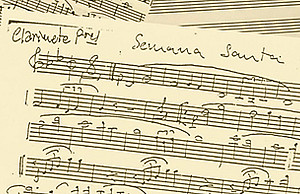La Procesión del Resucitado hunde sus raíces en el siglo XVII, y esta y su ceremonial se desarrollan en torno a la Imagen de Nuestra Señora de la Soledad, que acompañaba bien a la Custodia, bien a una Imagen de Jesús Resucitado cuya existencia sí está constatada ya en el siglo XIX, cuando dicha Imagen recibe culto en la Iglesia parroquial de Nuestra Señora de la Asunción en una de las hornacinas de la capilla del Santísimo.
De su filiación nos han llegado datos a través del Libro de Cuentas de la Cofradía de Jesús, a la que el Paso de Jesús Resucitado, popularmente conocido desde siempre como 'El Niño Resucitado', debió estar adscrito; así se desprende de este curioso apunte de 1901 que se repite en 1920: "factura por un tornillo para el Niño Resucitado".
Por los documentos gráficos de principios de siglo XX conservados se sabe que esta primitiva Imagen de Jesús Resucitado, cuya autoría no es posible aventurar, era bastante más pequeña que la actual y de menor calidad artística. Fue restaurada por Sánchez Araciel en 1911 y desapareció durante la Guerra Civil.
El Paso de Jesús Resucitado es, desde su aparición en Cieza, el eje central en la tradicional Cortesía que se celebra el Domingo de Resurrección en la Esquina del Convento en el marco de la Procesión del mismo nombre. Desde finales del siglo XIX, cuando aquella tenía lugar en la Plaza del Comisario, el Paso de Jesús Resucitado, acompañado del de Santa María Magdalena, salía desde la Iglesia de Nuestra Señora de la Asunción por la calle del Cid hacia dicha Comisario, donde confluía con los Pasos de San Juan y de la Santísima Virgen del Amor Hermoso que habían salido por la calle Cartas, produciéndose de esa manera entre todos ellos el tradicional encuentro y las tres reverencias consecutivas de salutación.
Tras la contienda civil, el gremio de panaderos constituye en 1943 la Cofradía de Jesús Resucitado, para la que encargan, bajo la presidencia de D. José Molina Gómez, un nuevo Paso titular al escultor ciezano Manuel Juan Carrillo Marco. El Paso, integrado por las Imágenes de Jesús, saliendo del sepulcro sobre una nube, y de un Ángel, con la losa del sepulcro en las manos, montadas en un trono tallado en madera y dorado, desfiló por primera vez ese mismo año de 1943. Un año después el propio Carrillo añadió, inspirada en su propio retrato, la Imagen de un soldado romano caído de espaldas. El nuevo grupo escultórico fue instalado en una hornacina de la Ermita del Santísimo Cristo del Consuelo, desde donde cada tarde del Sábado Santo, y hasta la década de los ochenta del pasado siglo XX, se efectuaba su tradicional Traslado, el cual, con posterioridad, se ha vuelto a realizar en dos ocasiones más.
A finales de esa misma década la Cofradía del Santísimo Cristo del Consuelo se hizo cargo de procesionar el Paso, cuyos anderos cambiaron, bajo la presidencia de D. José Salor, las tradicionales túnicas blancas con ribetes azules, por las rojas propias de aquella Cofradía, e incorporaron a su vestuario en 2006 el tradicional gorro de 'moco'. Ya bajo la presidencia de D. Juan Ramos Montiel, la Cofradía culminó el proceso de restauración del trono y las Imágenes, que se llevaron a cabo en Cieza en los talleres artesanales de Bonifacio Pérez Ballesteros.
Fotografía de Manuel Carpio.
© Junta de Hermandades Pasionarias de Cieza















